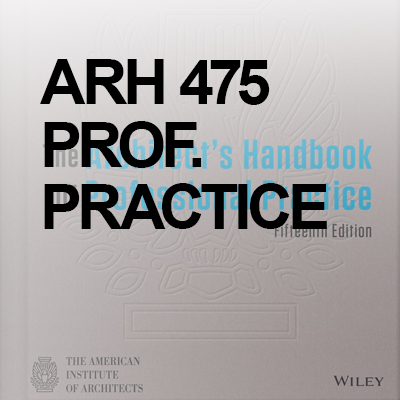
ARH 475 Professional Practices for Architects
Gain the legal and business knowledge to successfully transition into the architecture profession. You will examine contractual relationships among stakeholders, licensure process, organizational structures, ethics, business development, compensation, insurance, and the importance of mentorship.
Prerequisite: LA 485, ARH 350
Featured Image Courtesy Of: AIAS
Course Learning Outcomes
- Demonstrate an understanding of professional ethics, the regulatory requirements, and business processes shaping the practice of architecture
- Create sample mission statements and bylaws for an architecture firm as well as sample client proposals with a fee structure and scope of services
- Compare modes of practice between firms of different sizes and organizational structures
- Identify pathways to licensure and career tracks, challenge systemic barriers, and promote inclusivity in the profession
- Determine modes of collaboration and dispute resolution for diverse constituents and multidisciplinary teams
- Critique and discuss how architectural practice can ameliorate or exacerbate public health, safety, and welfare
- Recognize the importance of continuing education for understanding architecture’s role in cultural, social, environmental, economic, and built contexts
NAAB Criteria
- This course addresses NAAB PC.1 Career Paths: How the program ensures that students understand the paths to becoming licensed as an architect in the United States and the range of available career opportunities that utilize the discipline’s skills and knowledge
- This course addresses NAAB PC.6 Leadership and Collaboration: How the program ensures that students understand approaches to leadership in multidisciplinary teams, diverse stakeholder constituents, and dynamic physical and social contexts, and learn how to apply effective collaboration skills to solve complex problems
- This course addresses NAAB SC.2 Professional Practice (understanding): How the program ensures that students understand professional ethics, the regulatory requirements, the fundamental business processes relevant to architecture practice in the United States, and the forces influencing change in these subjects
- This course addresses NAAB Shared Values of Equity, Diversity, and Inclusion: Architects commit to equity and inclusion in the environments we design, the policies we adopt, the words we speak, the actions we take, and the respectful learning, teaching, and working environments we create. Architects seek fairness, diversity, and social justice in the profession and in society and support a range of pathways for students seeking access to an architecture education
- This course addresses NAAB Shared Values of Leadership, Collaboration, and Community Engagement: Architects practice design as a collaborative, inclusive, creative, and empathetic enterprise with other disciplines, the communities we serve, and the clients for whom we work
- This course addresses NAAB Shared Values of Lifelong Learning: Architects value educational breadth and depth, including a thorough understanding of the discipline’s body of knowledge, histories and theories, and architecture’s role in cultural, social, environmental, economic, and built contexts. The practice of architecture demands lifelong learning, which is a shared responsibility between academic and practice settings
